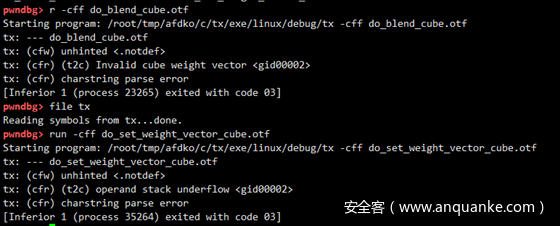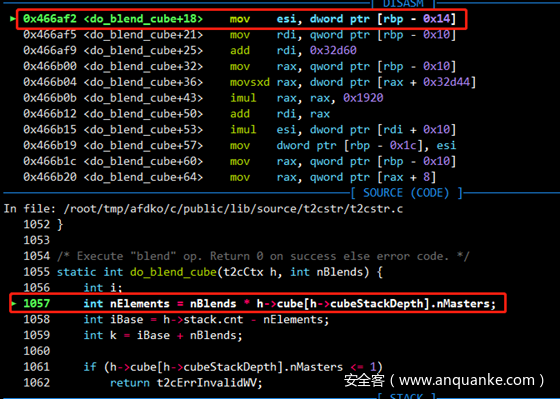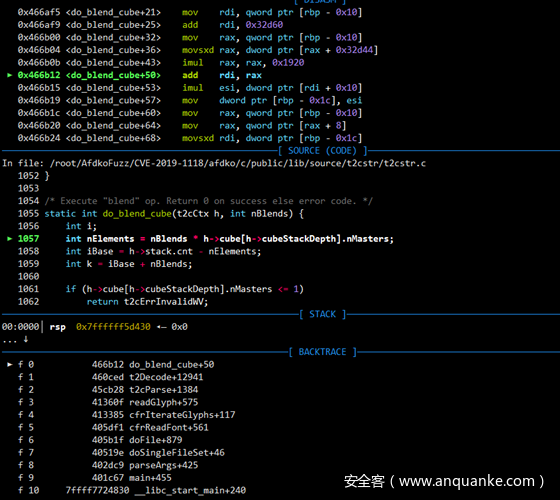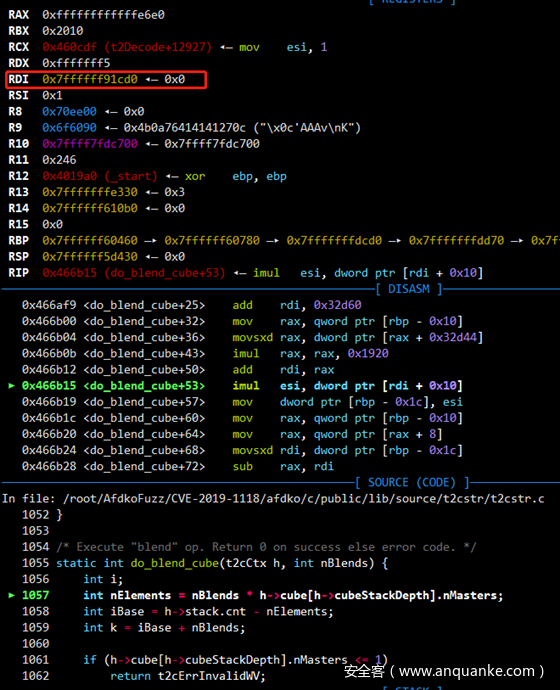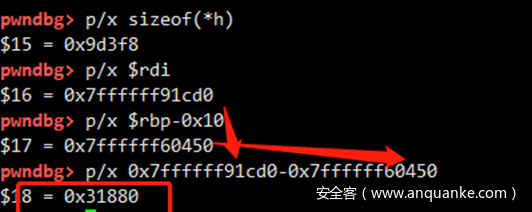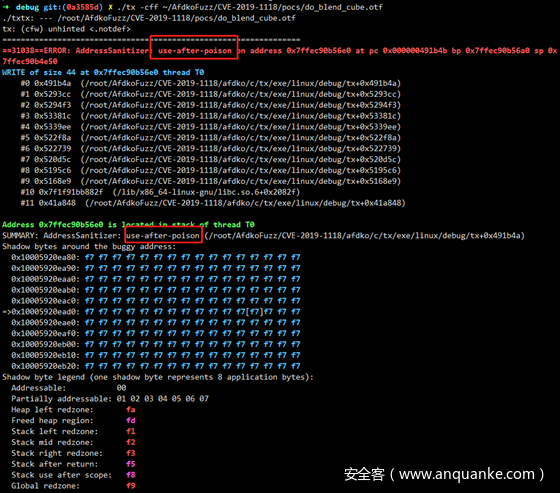这篇来分析一下CVE-2019-1118,问题为stack corruption in OpenType font handling due to negative cubeStackDepth
漏洞复现
搭建环境,简单复现一下
git clone https://github.com/adobe-type-tools/afdko
cd afdko
git checkout 2.8.8
cd c
bash buildalllinux.sh debug根据给出的poc测试
可以发现,出错了,但是被afdko捕获了。
这样的话,在重点位置设一下断点,再来看一下
首先测试一下do_blend_cube.otf
pwndbg> b t2cstr.c:1057
Breakpoint 1 at 0x466af2: file ../../../../../source/t2cstr/t2cstr.c, line 1057.
pwndbg> run -cff do_blend_cube.otf看一下效果
结合着反汇编代码看,效果可能更好
.text:0000000000466AF2 mov esi, [rbp+nBlends]
.text:0000000000466AF5 mov rdi, [rbp+h]
.text:0000000000466AF9 add rdi, 32D60h
.text:0000000000466B00 mov rax, [rbp+h] ; h
.text:0000000000466B04 movsxd rax, dword ptr [rax+32D44h]; 取得索引
.text:0000000000466B0B imul rax, 1920h; cube大小
.text:0000000000466B12 add rdi, rax
.text:0000000000466B15 imul esi, [rdi+10h]
.text:0000000000466B19 mov [rbp+nElements], esi可以发现h->cube数组取值是通过乘法实现的,当索引为-1即h->cubeStackDepth==-1时,
imul rax, 1920h ==> imul 0xffffffff, 1920hcube数组每项的大小:sizeof(h->cube[0]) == 0x1920
再变换一下
((struct cube)h->cube)-1相当于h->cube指针向前移动了一个数组值,即0x1920个字节
再来看看struct _t2cCtx的大小
向前移动了,但是((struct cube)h->cube)-1的位置还是在_t2cCtx结构体中,验证一下
继续单步执行到这,索引值得出
继续si
此时
可以发现0x9d3f8 > 0x31880 ,验证也确实还在结构体中。
这样的话,即使是h->cubeStackDepth==-1也不会导致内存访问出错,最多也就是分析错误,被afkdo捕获也就不奇怪了。我们的结果也确实是这样
但是PJ0给的例子中,存在了一个叫做redzone patch的操作,打完patch之后会出现user-after-poison的错误。
就像这样
==96052==ERROR: AddressSanitizer: use-after-poison on address 0x7ffea1a88890 at pc 0x00000069e6e2 bp 0x7ffea1a46bb0 sp 0x7ffea1a46ba8
READ of size 4 at 0x7ffea1a88890 thread T0
#0 0x69e6e1 in do_blend_cube afdko/c/public/lib/source/t2cstr/t2cstr.c:1057:58
#1 0x6855fd in t2Decode afdko/c/public/lib/source/t2cstr/t2cstr.c:1857:38
#2 0x670a5b in t2cParse afdko/c/public/lib/source/t2cstr/t2cstr.c:2591:18
#3 0x542960 in readGlyph afdko/c/public/lib/source/cffread/cffread.c:2927:14
#4 0x541c32 in cfrIterateGlyphs afdko/c/public/lib/source/cffread/cffread.c:2966:9
#5 0x509662 in cfrReadFont afdko/c/tx/source/tx.c:151:18
#6 0x508cc3 in doFile afdko/c/tx/source/tx.c:429:17
#7 0x506b2e in doSingleFileSet afdko/c/tx/source/tx.c:488:5
#8 0x4fc91e in parseArgs afdko/c/tx/source/tx.c:558:17
#9 0x4f9470 in main afdko/c/tx/source/tx.c:1631:9
#10 0x7fa93072e2b0 in __libc_start_main
#11 0x41e5b9 in _start
如果我们想这样的话,该怎么做呢?
很遗憾,关于手动设置redzone的资料特别少,中文基本上就是纯空白了。而且我发现,基本上这个方法就是PJ0自己成员在用,其他人很少有使用过的。
为了实现这个功能,我把sanitizer的实现资料和相关redzone的源码全部简单过了一遍,最后弄懂了redzone的相关定义和用法,这部分想要了解的话,自己查资料吧,内容比较多,可以重点看一下PJ0介绍sanitizer的几个paper。
最后在sanitizer/asan_interface.h中看到了这部分代码
//===-- sanitizer/asan_interface.h ------------------------------*- C++ -*-===//
//
// Part of the LLVM Project, under the Apache License v2.0 with LLVM Exceptions.
// See https://llvm.org/LICENSE.txt for license information.
// SPDX-License-Identifier: Apache-2.0 WITH LLVM-exception
//
//===----------------------------------------------------------------------===//
//
// This file is a part of AddressSanitizer (ASan).
//
// Public interface header.
//===----------------------------------------------------------------------===//
#ifndef SANITIZER_ASAN_INTERFACE_H
#define SANITIZER_ASAN_INTERFACE_H
#include <sanitizer/common_interface_defs.h>
#ifdef __cplusplus
extern "C" {
#endif
/// Marks a memory region (<c>[addr, addr+size)</c>) as unaddressable.
///
/// This memory must be previously allocated by your program. Instrumented
/// code is forbidden from accessing addresses in this region until it is
/// unpoisoned. This function is not guaranteed to poison the entire region -
/// it could poison only a subregion of <c>[addr, addr+size)</c> due to ASan
/// alignment restrictions.
///
/// \note This function is not thread-safe because no two threads can poison or
/// unpoison memory in the same memory region simultaneously.
///
/// \param addr Start of memory region.
/// \param size Size of memory region.
void __asan_poison_memory_region(void const volatile *addr, size_t size);
/// Marks a memory region (<c>[addr, addr+size)</c>) as addressable.
///
/// This memory must be previously allocated by your program. Accessing
/// addresses in this region is allowed until this region is poisoned again.
/// This function could unpoison a super-region of <c>[addr, addr+size)</c> due
/// to ASan alignment restrictions.
///
/// \note This function is not thread-safe because no two threads can
/// poison or unpoison memory in the same memory region simultaneously.
///
/// \param addr Start of memory region.
/// \param size Size of memory region.
void __asan_unpoison_memory_region(void const volatile *addr, size_t size);
// Macros provided for convenience.
#if __has_feature(address_sanitizer) || defined(__SANITIZE_ADDRESS__)
/// Marks a memory region as unaddressable.
///
/// \note Macro provided for convenience; defined as a no-op if ASan is not
/// enabled.
///
/// \param addr Start of memory region.
/// \param size Size of memory region.
#define ASAN_POISON_MEMORY_REGION(addr, size) \
__asan_poison_memory_region((addr), (size))
/// Marks a memory region as addressable.
///
/// \note Macro provided for convenience; defined as a no-op if ASan is not
/// enabled.
///
/// \param addr Start of memory region.
/// \param size Size of memory region.
#define ASAN_UNPOISON_MEMORY_REGION(addr, size) \
__asan_unpoison_memory_region((addr), (size))
#else
#define ASAN_POISON_MEMORY_REGION(addr, size) \
((void)(addr), (void)(size))
#define ASAN_UNPOISON_MEMORY_REGION(addr, size) \
((void)(addr), (void)(size))
#endif宏定义ASAN_UNPOISON_MEMORY_REGION指向__asan_poison_memory_region,利用这个函数可以设置redzone,之后利用__asan_unpoison_memory_region解除设置
方法找到了,那就来看具体代码,设置redzone,在do_blend_cube函数中
/* Execute "blend" op. Return 0 on success else error code. */
static int do_blend_cube(t2cCtx h, int nBlends) {
int i;
__asan_poison_memory_region(h->cube-1, sizeof(struct _t2cCtx)); // 设置redzone
int nElements = nBlends * h->cube[h->cubeStackDepth].nMasters;
int iBase = h->stack.cnt - nElements;
int k = iBase + nBlends;
if (h->cube[h->cubeStackDepth].nMasters <= 1)
return t2cErrInvalidWV;
CHKUFLOW(h, nElements);
if (h->flags & FLATTEN_CUBE) {
for (i = 0; i < nBlends; i++) {
int j;
double x = INDEX(iBase + i);
for (j = 1; j < h->cube[h->cubeStackDepth].nMasters; j++)
x += INDEX(k++) * h->cube[h->cubeStackDepth].WV[j];
INDEX(iBase + i) = (float)x;
}
} else {
float blendVals[kMaxCubeMasters * kMaxBlendOps];
for (i = 0; i < nElements; i++) {
blendVals[i] = INDEX(iBase + i);
}
callback_blend_cube(h, nBlends, nElements, blendVals);
}
h->stack.cnt = iBase + nBlends;
__asan_unpoison_memory_region(h->cube-1, sizeof(struct _t2cCtx)); // 解除redzone
return 0;
}这里有一点需要注意,poison的size一定要设置的够大,否则会没有poison的效果,我这里是取_t2cCtx结构体的大小,这样就保证了怎么移动我们都能检测到
来看一下效果
fuzzing 代码
还是这么写main函数
/* Main program. */
int CTL_CDECL main(int argc, char *argv[]) {
txCtx h;
char *progname;
/* Get program name */
progname = tail(argv[0]);
--argc;
++argv;
/* Allocate program context */
h = malloc(sizeof(struct txCtx_));
if (h == NULL) {
fprintf(stderr, "%s: out of memory\n", progname);
return EXIT_FAILURE;
}
memset(h, 0, sizeof(struct txCtx_));
h->app = APP_TX;
h->appSpecificInfo = NULL; /* unused in tx.c, used in rotateFont.c & mergeFonts.c */
h->appSpecificFree = txFree;
txNew(h, progname);
h->t1r.flags = 0; /* I initialize these here,as I need to set the std Encoding flags before calling setMode. */
h->cfr.flags = 0;
h->cfw.flags = 0;
h->dcf.flags = DCF_AllTables | DCF_BreakFlowed;
h->dcf.level = 5;
h->svr.flags = 0;
h->ufr.flags = 0;
h->ufow.flags = 0;
h->t1w.options = 0;
// 设置cff模式
setMode(h, mode_cff);
// argv[1] 文件名,对应上面argv--
doSingleFileSet(h, argv[0]);
if (h->failmem.iFail == FAIL_REPORT) {
fflush(stdout);
fprintf(stderr, "mem_manage() called %ld times in this run.\n",
h->failmem.iCall);
}
txFree(h);
return 0;
}出现异常利用上面的测试一下即可。
fuzz代码我公开了,测出有效洞可得找我哈 : )
还不会的话,只能看我的具体项目了,一起学习fuzz哈

